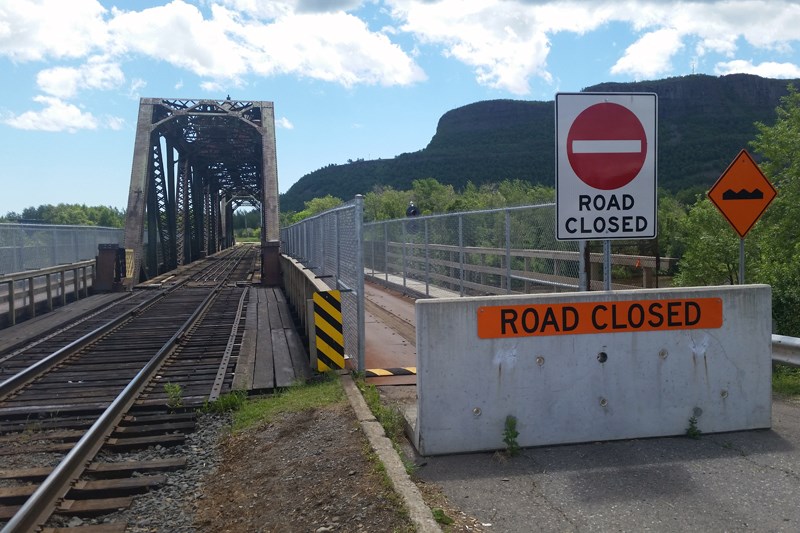THUNDER BAY – The Ontario Court of Appeal has ruled the Canadian National Railway must reopen the James Street Swing Bridge to vehicular traffic and that the nearly five-year closure of the span breached the original 1906 agreement.
In a decision released on Monday, the court allowed the City of Thunder Bay’s appeal to force CN to reopen the span, overturning last year’s Ontario Superior Court of Justice ruling.
The bridge, which connects the city to Fort William First Nation across the Kaministiquia River, has been closed to vehicles since a fire broke out on the northern approach spans on the night of Oct. 29, 2013, though trains were able to resume crossing later that week.
CN had argued that even though fire damage was limited, the bridge would need repairs and upgrades beyond maintenance to meet current standards. The railway raised specific concern to the possibility of a vehicle crashing through the wooden pedestrian walkway if it left the roadway.
“The ‘errant’ vehicle CN claims to be concerned about has never manifested itself. Virtually no activity is risk free. But the risk of an errant vehicle going into the river must be minimal with three speed bumps and a speed limit of 20 kilometres per hour on the bridge,” the decision reads.
“One might have thought that, having repaired the minor damage caused by the fire, CN could simply have reopened the bridge, and maintained it for vehicular traffic as it and its predecessors have done, without incident, for over 100 years.”
There is no specific deadline included in the decision for when the bridge must be reopened.
“That bridge is functional. With maintenance, it can be reopened,” Thunder Bay city manager Norm Gale said at a news conference about 30 minutes after the decision was released.
“This bridge is an important piece of infrastructure for both our communities. We’re pleased CN has been ordered to reopen that bridge.”
Fort William First Nation chief Peter Collins, who has previously voiced concern that a favourable ruling would result in further appeals that would prolong the closure, joined city officials at the news conference and expressed cautious optimism.
“We’re excited about the ruling but we don’t want to get overjoyed with it because we’re not sure what will unfold next,” Collins said.
Superior Court Justice Patrick Smith, who previously ruled against the city’s initial case, wrote they fell short of providing a specific and detailed proposal of what CN needed to do to make the bridge safe.
The appeal court deemed that to be unnecessary.
“The application judge erred by placing an onus on Thunder Bay to provide a proposal to make the bridge safe for motor vehicles. CN has a contractual obligation to maintain the bridge for motor vehicles in perpetuity, an obligation it has breached,” the appeal court decision reads.
“To rectify its breach, CN must reopen the bridge; it therefore has the onus to determine what maintenance is needed to alleviate any safety concerns associated with the bridge’s reopening.”
The 1906 agreement signed by the Town of Fort William and Grand Trunk Pacific – now represented by Thunder Bay and CN respectively – ordered the railway to provide the citizens of the municipality the “perpetual right” to cross the span.
Construction of the bridge was completed in 1909 at a cost of $230,000, with $50,000 of that coming from the town.
“The right to cross the bridge perpetually, and the obligation to maintain the bridge in perpetuity, can only mean that the parties intended the bridge to be open for any kind of vehicle, not just horses and carts,” the decision reads, disagreeing with CN's assertion that it should only apply to modes of transportation utilized at the time of the agreement.
The city had spent $1.3 million pursuing the case through the courts, Dougall Media had learned last week after filing a freedom of information request. The appeal court decision also awarded the city $290,000 in costs.
In a brief statement issued to Tbnewswatch, CN's vice-president (law), Olivier Chouc, said "CN will want to review the decision before commenting."
Chouc added, however, that "regardless of outcome, CN wants to continue to work with the City and Fort William First Nation to try and find a solution."
James Street Swing Bridge timeline
- Oct. 29, 2013: Fire breaks out on the bridge, closing both the road and rail portions of the structure.
- Nov. 1, 2013: Rail traffic resumes crossing the bridge.
- Feb. 9, 2015: Thunder Bay city council rejects CN's "final offer" to reopen bridge without going to court.
- Feb. 20, 2015: CN files case before Ontario Superior Court of Justice, requesting judge to determine its obligations under 1906 agreement.
- Feb. 24, 2015: City announces it has filed its own Superior Court suit, arguing CN should be bound by the 1906 agreement to maintain the bridge.
- Jan. 20, 2016: Superior Court Justice John Fregeau rules city's application to proceed with CN's case to be stayed.
- April 2016: Office of the Fire Marshal completes investigation into fire, classifying cause as undetermined.
- July 7, 2016: City-contracted engineers granted access to inspect the bridge.
- March 1-3, 2017: Case is heard in a Thunder Bay courtroom by Superior Court Justice Patrick Smith.
- June 9, 2017: Ontario Superior Court Justice Patrick Smith dismisses the city's case, ruling CN does not have to reopen the bridge.
- July 10, 2017: City files notice of appeal before the Ontario Court of Appeal
- Jan. 25, 2018: The Ontario Court of Appeal hears the case.
- June 11, 2018: The Ontario Court of Appeal accepts the city's appeal, finding CN breached 1906 agreement and orders railway to reopen the bridge.
